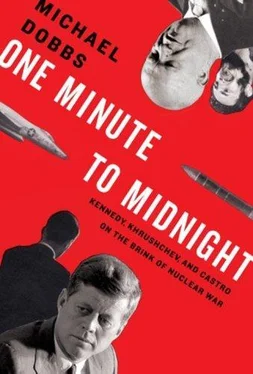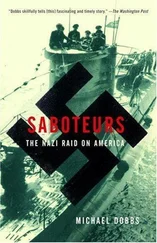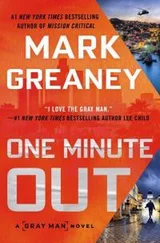“establish a pattern of operation”: JFK3, 240; flight tracks for October 27 reported in NPIC Photo Interpretation Report on Missions 5017-5030, CREST.
The canvas covers had been taken off: JCS meeting notes for October 27, 1962, Havana 2002, vol. 2. The notes were made in 1976 by a JCS historian, Walter Poole, on the basis of original transcripts. According to the JCS, the original transcripts were subsequently destroyed. Photographs taken by these missions are contained in SAC Historical Study No. 90, Vol. 2, FOIA.
“First of all”: Malakhov notes, MAVI.
“The people at large”: British Archives on the Cuban Missile Crisis, 242.
“a city of children”: Saverio Tutino, L’Occhio del Barracuda (Milan: Feltrinelli, 1995), 134.
“Of course we were frightened”: Desnoes interview.
“We are expecting”: Adolfo Gilly, “A la luz del relampago: Cuba en octubre,” Perfil de la Jornada, November 29, 2002.
“Keep two or three buckets”: FBIS trans. of Radio Rebelde, October 28, 1962.
“ Love Thy Neighbor ”: October 27 UPI report from Havana; see NYT, October 28, 1962.
On a hill above: Author’s interview with Alfredo Duran, former inmate, December 2005.
“Destroy Target Number 33”: Gribkov et al., U Kraya Yadernoi Bezdni, 124; Putilin, 111-12. There are slight variations in the time of the shootdown. I have relied on the time given by Col. Korolev, who was on duty at the Camaguey command post (see Gribkov et al., 250). For the location of the wreckage, see October 28, 1962, report from Unidad Military 1065, NSAW Cuba.
“ Que vivan los Sovieticos ”: Gribkov et al., U Kraya Yadernoi Bezdni, 235.
a “munitions storage site”: See NPIC reports, October 26 and October 27, 1962, CREST.
The commander of the missile troops: Yesin et al., Strategicheskaya Operatsiya Anadyr’, 67.
On the other hand: Statsenko report; Yesin interview.
“You are irritating”: Malinovsky (Trostnik) order to Pliyev, October 27, 1962, NSAW Cuba, author’s trans. See a different trans. in CWIHP, 14-15 (Winter 2003), 388.
“bearded, energetic man”: Gribkov and Smith, Operation ANADYR, 69.
“the definitive victory”: Verde Olivo, October 10, 1968, quoted in Carla Anne Robbins, The Cuban Threat (New York: McGraw-Hill, 1983), 47.
“established a military command post”: CIA memorandum, The Crisis: USSR/Cuba, October 26, 1962, CREST; author’s visit to Cueva de los Portales; Blue Moon missions 5019-5020, October 27, 1962, NPIC report, CREST.
the “final stage”: Blue Moon missions 5023-5024, NPIC report, CREST.
The Soviets had even dropped a live: See, e.g., David Holloway, Stalin and the Bomb (New Haven, CT: Yale University Press, 1994), 326-8.
Nuclear-capable IL-28s: CIA memorandum, The Crisis: USSR/Cuba, November 6, 1962, CREST. The CIA reported that the Air Force IL-28s “almost certainly” arrived on the Leninsky Komsomol, which docked near Holguin on October 20. According to Brugioni, Eyeball to Eyeball, 173, NPIC already had its eye on Holguin because of construction activity similar to that seen in the Soviet Union prior to the deployment of IL-28s. Unlike the IL-28s at San Julian, the planes at Holguin were never taken from their crates, and were removed around November 26—Brugioni, 536.
“those things that nobody”: Anastasiev interview.
According to the original Defense Ministry: Malinovsky memoranda, September 6 and 8, 1962, trans. in CWIHP, 11 (Winter 1998), 258-60. See also Raymond Garthoff, “New Evidence on the Cuban Missile Crisis,” ibid., 251-4.
“In the event”: CINCONAD message 262345Z, CNO Cuba, USNHC; for JCS reply, see Chronology of JCS Decisions Concerning the Cuban Crisis, October 27, 1962, NSAW Cuba, and OPNAV 24-hour resume of events, 270000 to 280000, CNO Cuba, USNHC.
“an atomic delivery”: Chronology of JCS Decisions, October 28, 1962, NSAW Cuba.
“any movement of FROG”: CINCLANT history, 95.
After earlier discounting: Blight et al., Cuba on the Brink, 255, 261; amendment to CINCLANT history, JCS request for casualty estimates, November 1, 1962, CNO Cuba, USNHC.
The nuclear cores for the bombs: Polmar and Gresham, 230; USCONARC message to CINCLANT 291227Z, CNO Cuba, USNHC.
a “surprise first strike”: Taylor memos to McNamara and the President, May 25, 1962, JCS records, NARA.
“I know the Soviet Union”: Sorensen OH, JFKL.
At the same time that U.S. generals: JCS memo to McNamara, October 23, 1962; Gilpatric memos to President and Bundy, October 24, 1962; Sagan Collection, NSAW; Sagan, 106-11. On October 22, Gilpatric had told aides that he saw no reason for a change in rules governing the two-stage weapons—Gilpatric desk diary, OSD.
“so loose, it jars”: Lt. Col. Robert Melgard quoted in Sagan, 110.
As the B-52 began a series: Author’s interview with 1st Lt. George R. McCrillis, pilot on CALAMITY, February 2006.
“Three minutes—NOW”: Procedures described in Dominic Operations Plan, September 1962, History of Air Force Participation in Operation Dominic, Vol. III, DOE.
CHAPTER ELEVEN: “SOME SONOFABITCH”
Alone in the vast blackness: Maultsby memoir.
The befuddled pilot: Data tracking Maultsby’s U-2 and Soviet interceptors are taken from U.S. government charts. I found the most detailed map in the files of the State Department Executive Secretariat, SDX, Box 7. A second map tracking Soviet interceptors that appear to have taken off from an air base at Pevek is located in National Security Files—Cuba, Box 54, Maps, charts, and photographs folder, JFKL.
“unusually somber and harried”: Brugioni, Eyeball to Eyeball, 456.
The mere mention of “civil defense”: Official transcript, McNamara press conference, October 22, 1962, OSD.
If the Soviets attacked: Report to National Governors’ Conference by Assistant Defense Secretary Steuart L. Pittman, October 27, 1962, JFKL.
Earlier in the week: Steuart L. Pittman OH, JFKL.
In the absence of government action: Alice L. George, Awaiting Armageddon: How Americans Faced the Cuban Missile Crisis (Chapel Hill: University of North Carolina Press, 2003), 78-80.
“Invade Cuba, Attack the Reds”: AP and UPI reports, October 27, 1962; WP, October 28, 1962.
General Power was on: Author’s interview with Maj. Orville Clancy, former SAC HQ officer, June 2003.
“Peace is our Profession”: Reminiscences of Col. Maynard White, America’s Shield, The Story of the Strategic Air Command and Its People (Paducah, KY: Turner, 1997), 98.
“what the hell you are doing”: Des Portes OH, NSAW.
The ability to “read the mail”: Interviews with Clancy; Gerald E. McIlmoyle; and former SAC intelligence officer James Enney, October 2005.259 “We have a problem”: Author’s interview with Fred Okimoto, August 2005.
“while engaged in a high-altitude”: Taubman, 455.
His thoughts went back: Maultsby was shot down over North Korea on January 5, 1952; he was released on August 31, 1953—Maultsby personnel file, NPRC. A copy of his interrogation record by the North Koreans was supplied to Russia, and released through the U.S.-Russia Joint Commission on POWs/MIAs.
“the muzzles of”: Martin Caidin, The Silken Angels: A History of Parachuting (Philadelphia: J. B. Lippincott, 1964), 230-6.
“missing in action”: Maultsby personnel file.
When he learned of the stand-down order: Correspondence and interview with McNamara aide Col. Francis J. Roberts, May 2006.
“Tell the admiral”: CNO Office logs, October 27, 1962, CNO Cuba, USNHC. The naval aide was Capt. Isaac C. Kidd, Jr.
Читать дальше












